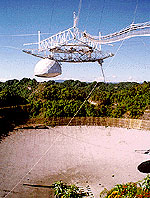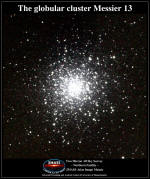|
by John Walker
Suppose, during a routine observing session on the 305
meter radio
telescope at
Arecibo Observatory in Puerto Rico, a faint, narrow
band signal were detected at a frequency of 2388 MHz (12.6
centimeter wavelength) and that after a variety of tests ruled out
interference from terrestrial sources, Earth satellites or planetary
probes, artifacts due to equipment failure or miscalibration, or
even a prank on the part of a member of the observing team,
astronomers began to
After all, when the fast, extraordinarily precise signals from pulsars were first detected, they too appeared so unlike other astronomical sources that some suspected they were interstellar beacons and referred to them as "LGM sources" (for "Little Green Men").
In the case of the pulsars, theorists
suggested that quickly rotating neutron stars with intense magnetic
fields could produce signals like those observed, and subsequent
observations confirmed that theory beyond a shadow of a doubt.
Further, intense
scrutiny of the signal reveals a Doppler shift consistent with its
source being in a 230 day orbit around the star. Finally, after
round-the-clock observations of the signal by observatories all over
the globe and reduction of the observations with supercomputers, it
is found to be modulated, repeating the same sequence of 1679
on-and-off pulses over and over.
The
signal would be acknowledged by virtually all observers to be a
message transmitted by intelligent extraterrestrials. The relentless
Copernican demotion of Homo sapiens from the centre of the universe
would be complete; we would know we were not alone in a dead and
meaningless universe, but rather an outpost of life and
consciousness, in all probability one among a multitude, just having
received our invitation to connect to the galactic Internet.
At first glance, this might appear to be an unsolvable puzzle: not only do we share no common language with the beings who sent the message, we can't even be sure they have the same sense organs - perhaps the creatures who sent the message are gasbags who live in the eternal night deep in the atmosphere of a Jupiter-like gas giant planet and communicate chemically - by emitting and sensing odors.
Consider two human beings, one knowing only Japanese, another only Portuguese, trying to establish communication by sending telegrams to one another.
Hopeless! - yet Japanese and Portuguese are members of the same species who, other than the language they learned as children, are for all intents and purposes identical.
How can we possibly hope to comprehend a
message from a species with no common lineage whatsoever?
From first principles, one can determine the frequency bands in which the universe is largely transparent; if the transmitting species lacked senses capable of revealing the existence of other stars, for what conceivable reason would they be motivated to squander energy beaming a transmission into the murky dark? No - it's a safe bet any being which sends an electromagnetic message will have senses which respond to electromagnetic radiation.
But in what wavelength band?
After all, prior to the 20th century,
our own species was unaware of all but the tiny optical octave of
the electromagnetic spectrum. Again, there is an obvious answer. A
life form which evolves on an Earthlike planet circling a star is
almost certain to have a visual sense with maximum acuity in the
predominant wavelengths which reach the surface. Vision is of such
value that an enormous variety of terrestrial species possess it.
Each could send the other freehand drawings of various things, with the words for them written alongside. For those objects recognizable to both, this would allow compiling a vocabulary of each other's languages.
With a little more artistic creativity,
verbs, adjectives, and other parts of speech could be exchanged.
Eventually, effective communication could be established. Might it
not be the same between humans and extraterrestrials? If we received
an image, we might be able to make enough sense of it to learn
something about the senders and, perhaps, how to obtain more
detailed messages.
This suggests that the bits might be arranged in rectangular array with those dimensions. Well, there's two ways to do it; first we try 23 rows of 73 columns: gibberish. Then we try the other, 73 rows of 23 columns and...Eureka!
Here is the rearranged message with the
ones written in darker type so they stand out more clearly. Since this is an image, let's look at it as one, at the right.
The first thing that jumps out at us is the humanoid figure in the middle of the image toward the bottom. Imagining a natural process which could cause a binary message containing such an image over and over would be a daunting task for even the most skeptical theorist.
The image as a whole would be irrefutable evidence of an intelligent sender. Dissecting the image piece by piece, we may discover a multitude of information about whoever sent it.
Recall that this document began with the word "suppose". No, radio astronomers have not detected any signals from other intelligent species, at least not yet.
But they have sent them - at least as a symbolic gesture.
As part of a ceremony to inaugurate a major upgrade to the Arecibo radio telescope, Frank Drake, then director of the centre which operates the telescope, arranged to have the message shown here transmitted in the direction of M-13, the Great Cluster in Hercules, using the telescope's half million watt radar transmitter at a frequency of 2388 MHz, corresponding to a wavelength of 12.6 cm.
The focusing of the transmission by the 305 meter antenna resulted in a beam with an effective radiated power of about 2×1012 watts - brighter than the Sun at that frequency.
The message was transmitted by modulating the transmission with two different frequencies, precisely as low-speed telephone modems do, with the data being sent at a rate of 10 bits per second.
Traveling at the speed of light, it will take 22,800 years for the message to reach the approximately 300,000 stars in M13, so if there are intelligent aliens living on planets of those stars, and they have radio telescopes, and they happen to be pointed in the Sun's direction when the message arrives, and are tuned to the correct frequency, and they identify this one-shot, less than three-minute transmission as a message, and they succeed in decoding it, and they decide to reply, you shouldn't hold your breath waiting for the answer to arrive.
M-13 in Hercules
Before it was transmitted toward M-13, the author of the message, Frank Drake, first beamed it on paper to Carl Sagan over lunch at the faculty club at Cornell University.
Prof. Sagan quickly figured out almost all of the message - can you?
(This is not an idle
puzzle - consider that when Frank Drake handed the message to Carl Sagan the two had known each other and collaborated on various
projects for more than a decade, and thus shared a context which
would help in decoding the message. If you're seeing this for the
first time, you may genuinely learn something about the difficulty
in establishing communications with a truly alien being by trying to
figure out what Frank Drake so earnestly encoded into the bits of
this message.)
I guarantee you'll learn a lot about how hard it is to communicate even relatively simple concepts across the gulf of space and time to beings who may have less in common with us than bacteria living at the vents along the mid-Atlantic ridge.
Good luck, and happy hunting!
|

 suspect they had just made one of the most
profound discoveries in the history of science - a beacon transmitted
by intelligent extraterrestrials.
suspect they had just made one of the most
profound discoveries in the history of science - a beacon transmitted
by intelligent extraterrestrials. 
